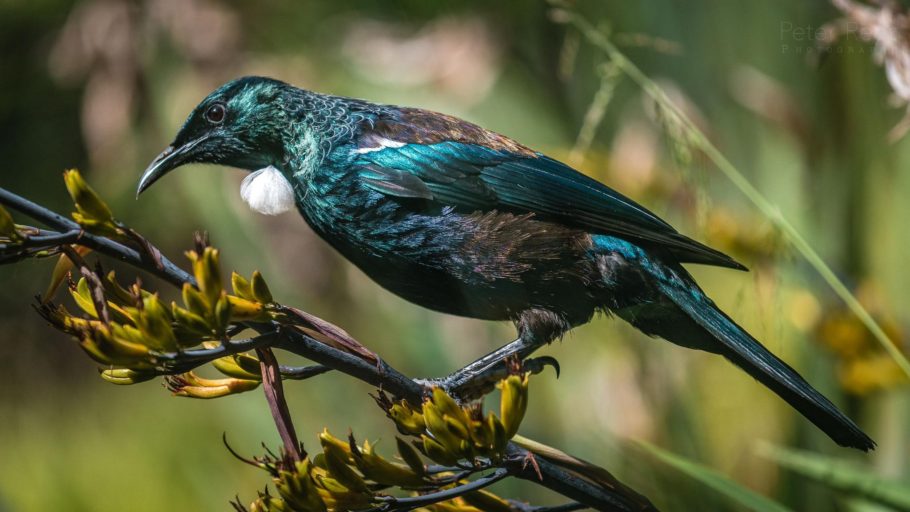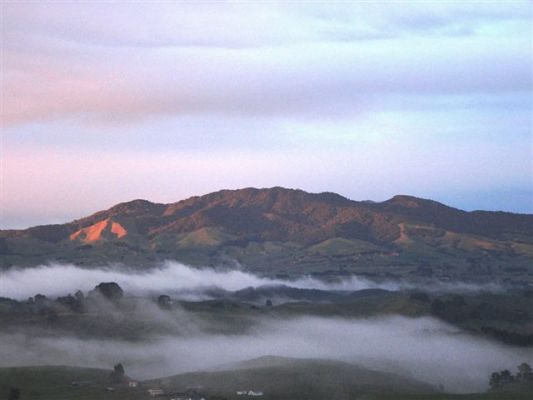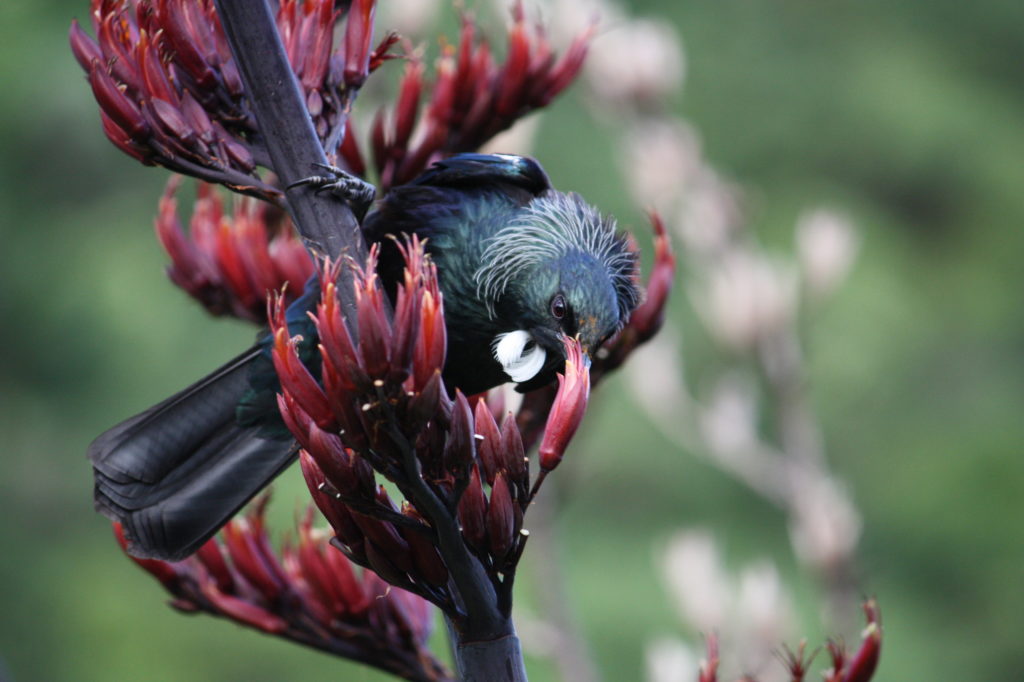Maungatautari Ecosanctuary is overflowing with tūī. They’re spilling over the predator proof fence into the surrounding community, according to an article just published in Notornis – the research journal of BirdsNZ. It’s great news for those who live near the sanctuary – especially those whose gardens include tūī favourites such as banksia, kōwhai and flowering cherry.

The study was carried out by Neil Fitzgerald, John Innes and Norman Mason from Manaaki Whenua/Landcare Research.
“We used tūī as a focal species because it is a conspicuous iconic species, and one of the native birds most familiar to members of the public,” the researchers report. “Tūī is an iconic New Zealand honeyeater, widespread throughout most of the country but sparse in dry, eastern, deforested parts of the South Island and some highly pastoral areas of the North Island. Before 2006, when we began this study, tūī were uncommon in central Waikato compared with many other parts of New Zealand.”
The researchers used 5-minute bird counts to estimate tūī numbers within the sanctuary and delivered questionnaires to residents living within 20km of Maungatautari to survey their experience of tūī encounters over a 9-year period following predator eradication at the sanctuary.

“Maungatautari is an extinct andesite volcano, approximately 30 km southeast of Hamilton city in central Waikato, with contiguous native forest cover from 240 to 797 m above sea level. The forest ranges from lowland rimu/tawa forest to montane forest dominated by tāwari, kāmahi, and tāwheowheo. Construction of a 47 km pest-resistant fence encircling 3,240 hectare of the forest was completed in August 2006 and eradication of all pest mammals except house mice commenced in November 2006. This created the largest area of virtually pest-free forest on the New Zealand mainland.”
The study area included the pest-fenced Maungatautari ecosanctuary and a near-circular largely unmanaged zone extending 20 km out from the perimeter pest fence.
“Land use within this 171,960 hectare unmanaged zone is predominantly intensive agriculture (88%; 150,970 ha) with fragments of exotic forest and scrub (5%; 7,870 ha), indigenous woody vegetation (4%; 7,650 ha), and urban and other built-up areas (< 2%; 2,850 ha. Indigenous vegetation and built-up areas are not distributed uniformly across the study area; 51% of the indigenous vegetation occurs 15–20 km from Maungatautari, and 96% of urban and built-up areas are 10–20 km from Maungatautari.”
Residents were surveyed residents biennially about their recollection of tūī presence and abundance at their property.
“Surveys were conducted in January–March 2007–2015 and referred to the preceding calendar year (2006–2014). To avoid self-selection, the survey questionnaire was delivered to mailboxes of 2,000 residents in January 2007, distributed proportionately by area in 5 km bands from the pest fence (0–5 km, n = 232; 5–10 km, n = 407; 10–15 km, n = 589; 15–20 km, n = 722). In subsequent surveys, questionnaires were delivered by post or email to all respondents who had participated in a previous survey and provided a valid address.”
Participants were asked:
1) What was the maximum number of tūī you saw at one time at your property during the previous year?
2) In what month(s) did this occur?
3) Do you think tūī have increased, decreased, or stayed the same since the previous survey?
4) Are tūī present at your property during summer (December– February, the main breeding season)?
5) Do tūī nest at your property?
6) Do you regularly put out food for tūī?

“The maximum number of birds seen at one time was chosen as a measure of abundance as nonbreeding congregation at preferred food sources is a conspicuous characteristic of tūī behaviour,” the authors explain. “It is also a simple and probably memorable measure that anecdotal reports suggested was often noted by the public without requiring specific instruction from us.”
In some cases, the reported congregations of tūī were phenomenal.
“Congregations of 100 or more tūī were reported 6 times. Such exceptional congregations of tūī have not been previously reported in Waikato. In late-August 2015, we visited the property where the largest number (300) had been reported in both 2012 and 2014,” the authors report. “This property was a large (approximately 10 hectare) rural garden 6.7 km from Maungatautari. The landowners noted that there were fewer tūī present that day than at the peak. Despite this, we estimated from counts and photographs that there were at least 210 tūī present, mostly in approximately 100 mature flowering Taiwan cherry trees (Prunus campanulata) from which they were feeding on nectar. This property demonstrates the potential for very large ephemeral congregations of tūī at sites with abundant food resources.”
During the breeding season (October to February in Waikato) tūī stay close to their nestsite.
“Tūī movement is restricted to a foraging range of approximately 500 m. However, they may forage widely (tens of km) during the non-breeding season, crossing large gaps of non-woody habitat. The diet of tūī includes nectar and fruit of a wide variety of native and introduced plants. This, combined with their ability to move large distances, makes tūī ecologically important pollinators and seed dispersers able to exploit novel environments such as urban and rural residential gardens.”
Predator control is necessary, however, for nesting success.
“In the absence of effective ship rat and brushtail possum management, tūī nesting success in the Waikato is poor. When the densities of these key introduced predators are reduced, tūī is one of the most conspicuously responsive species.”
It’s not surprising, therefore, that the creation of the sanctuary led to an increase in tūī abundance within the fenceline.
“Following pest eradication in the ecosanctuary, tūī relative abundance increased there and in the surrounding largely unmanaged area. The mean number of tūī per 5-minute count within the ecosanctuary was 2.23 in 2005 and increased following predator eradication in 2006 to 3.33 in 2008, 3.76 in 2011, and 2.68 in 2014. The mean maximum number of tūī at one time observed by residents in the largely unmanaged area increased from 4.4 (maximum = 47, number of survey respondents = 320) in 2006 to 15.6 (max = 300, n = 138) in 2014. Tūī numbers in both the ecosanctuary and the surrounding area were positively correlated with time since pest eradication. In the largely unmanaged area surrounding Maungatautari, tūī numbers were also positively correlated with provision of artificial food, and negatively correlated with distance from the ecosanctuary.”
The findings show that pest-free ecosanctuaries can help increase abundance of birds in surrounding landscapes if habitat is available.
“Where respondents gave additional information on the location of their observations, these typically described rural and urban gardens. Tūī aggregations were largest in spring (September–October) and smallest in early autumn (March). We received six reports of large congregations of ≥100 birds from five residents (2 in 2012 and 4 in 2014).”
The changes in tūī relative abundance both within and surrounding the ecosanctuary are evidence of spillover of tūī from Maungatautari into the surrounding landscape, which, the researchers say, has important biological and social implications.
“The increased presence of tūī in the wider landscape will help restore indigenous dominance in ecosystem processes such as pollination and seed dispersal. Furthermore, public awareness, engagement, and acceptance of pest mammal control are improved when people experience tangible benefits of restoration, such as tūī visiting their properties.”
Maximum counts of tūī at rural and urban residences were most often observed in spring, immediately before the breeding season.
“This is consistent with previous reports of pre-breeding congregation of tūī at preferred nectar sources. In the Waikato, these preferred food sources are typically coastal banksia, followed by kōwhai, flowering cherry, rewarewa, camellia, and eucalypts. Evidence for increased occurrence of nesting in gardens in the landscape surrounding Maungatautari during our study was not as strong as for non-breeding change. This is unsurprising, as tūī are often relatively inconspicuous when breeding, and the natal philopatry shown by Bergquist (1985) suggests that most of the tūī that disperse seasonally from Maungatautari will return there to breed.”
Land use in the study area surrounding the sanctuary is predominantly intensive agriculture with fragments of other habitat types.
“Connectivity between habitat patches (so-called ‘corridors’) is a key factor in spillover and the rescue-effect that can maintain species and genetic diversity in fragmented landscapes. The habitat matrix surrounding Maungatautari, and detailed studies of tūī movement, suggest that tūī readily cross pasture gaps of at least several kilometres, and this has potential for positive social and biodiversity gains over a considerably larger area than the fenced ecosanctuary alone. Biodiversity spillover is a key to achieving widespread benefit from the long-term goal to make New Zealand predator-free.”
Increased control of mammalian predators in the area surrounding the sanctuary, particularly in the tūī breeding season, would further enhance the spillover effect.
“Reducing the abundance of predators in the landscape surrounding the ecosanctuary may also provide scope for ‘evolutionary rescue’ of some species,” suggest the researchers. “Our results also show that maximum counts of tūī can provide an effective way to engage citizen science to monitor landscape-scale population dynamics of conspicuous, iconic species.”
The full article is published in Notornis and becomes freely available to non-subscribers one year after publication. Public libraries may also be able to provide access to the journal.

